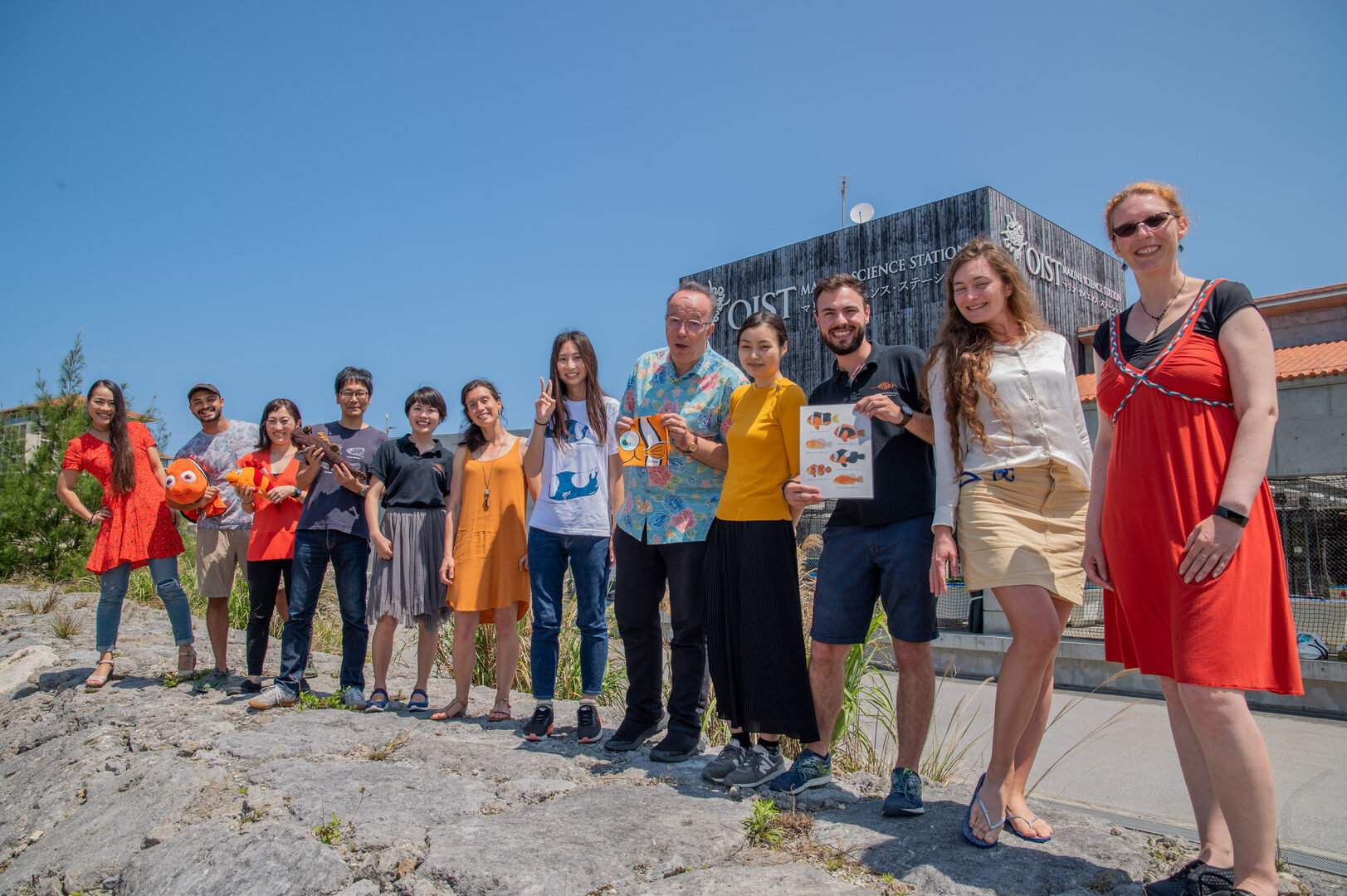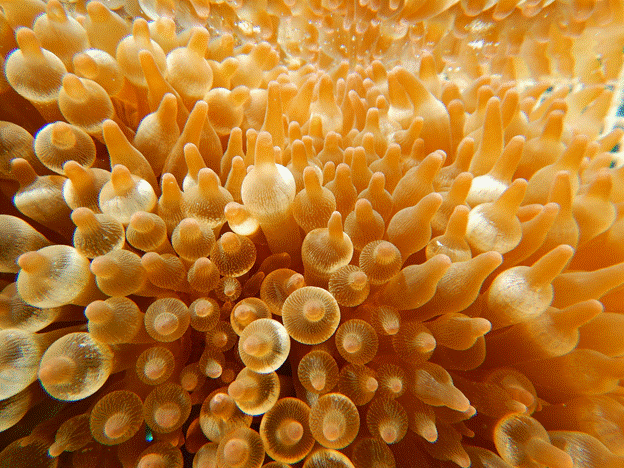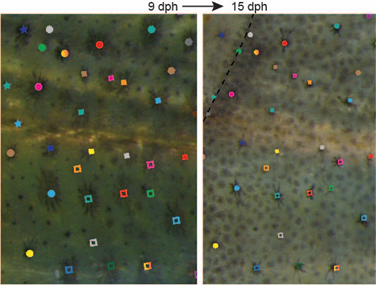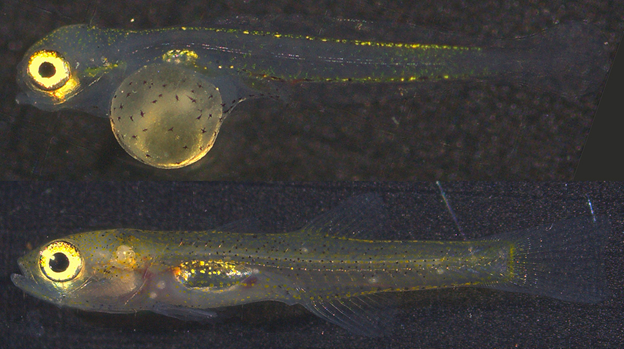FY2020 Annual Report
Marine Eco-Evo-Devo Unit
Professor Vincent Laudet

Abstract
The Marine Eco-Evo-Devo Unit uses the extraordinary diversity of coral reef fish to investigate the evolution of life history strategies in marine fishes, integrating ecological, evolutionary and developmental components. Using clownfishes as model systems we are particularly interested in how (i) hormonal signals intervene in evolutionary innovations, (ii) environment shapes developmental trajectories, and (iii) function and development of color patterns.
The year 2020 was the first year of the MEEDU unit! Because of the pandemic we had a slow start because many recruited members were unable to join because of travel restriction but finally they managed to join OIST. We are now 14 people in the unit! We had 4 rotation students: Yuki Tara who worked on how thyroid hormones regulate metabolism during clownfish metamorphosis, Rio Kashimoto who started a project on sea anemone genomics,Ayse Haruka Oshima Acikbas who compared the metamorphosis in various fish models using transcriptomics, and Minato Miyake who studied clownfish pigment cells using electron microscopy.
The unit has also started in our second location at Academia Sinica in Taiwan at Yilan Marine Research Station of ICOB (Institute of Cellular and Organismic Biology). Thanks to the work of Fiona Lee there we had our first paper entirely done in Asia published in Developmental Dynamics.
1. Staff
- Dr. Marleen Klann, Staff Scientist
- Dr Ken Maeda, Staff Scientist
- Dr. Manon Mercader, Postdoctoral Scholar
- Dr. Marcela Herrera Sarrias, Postdoctoral Scholar
- Dr. Saori Miura, Lab Manager
- Lilian Carlu, Husbandry Technician
- Mathieu Reynaud, Special Research Student
- Yuki Tara, PhD Student
- Rio Kashimoto, PhD Student
- Agneesh Barua, PhD Student
- Ayşe Haruka Oshima Açıkbaş, Rotation Student
- Minato Miyake, Rotation Student
- Yoko Fujitomi, Research Unit Administrator
2. Collaborations
2.1 Sea anemone genomics and diversity. A collaborative project between Laudet and Satoh units.
- Description: Mutualism between giant sea anemone and anemonefish ancestors is believed to have started 10 to 12 Myr ago. Even though the interest of this symbiosis is immediately clear in terms of protection for the anemonefish partners, much less is known about the advantage and constrains of this association for the sea anemone. To understand the mechanisms and evolutionary strategy of this symbiotic relationship for the sea anemone in collaboration with Satoh unit we decided to bring new information on giant sea anemones. Rio Kashimoto with Konstantin Khalturin in Satoh unit performed a transcriptomic analysis of the 7 species of giant sea anemones living in Okinawa to gain insight on the genome composition and gene content of these essential anemonefish partners. Our assembled data yield 95 – 98% of highly complete transcriptomic data. Phylogenetic analysis confirmed the organization of giant sea anemones in 3 groups: We found a first divergence happened between Entacmaea group and a group containing Heteractis and Stichodactyla, that then split. Furthermore, we confirmed data from the literature suggesting that Heteractis magnifica should in fact be included in the Stichodactyla clade.

The sea anemone Entacmaea quadricolor *Credit: Lilian CarluLilian Carlu - Type of collaboration: Joint research
- Researchers:
- Professor Nori Satoh, OIST
- Dr Konstantin Khalturin, Satoh unit
- Rio Kashimoto, PhD student
2.2 Color pattern, fin shape and water flow, how do anemonefish swim? A collaborative project between Laudet and Rosti units.
- Description: Understanding the link between animal morphology, color and ecology is not an easy task. In some fish species color pattern is known to be related to ecological factors such as differences in habitat use, behavior and social interaction, but the underlying mechanism is rarely understood. Given their relatively simple but still diverse color pattern anemonefish represent great models to investigate how differences in color could lead to differences in ecology. For instance, in those fish the number of bars is linked to differences in dorsal fin shape, species with three bars showing a bigger indentation than those with only one bar. It has been hypothesized that this difference in fin shape could be linked to differences in swimming capacities and thus different ecology. Using the six anemonefish species living in Okinawa as models, and a combination of various approaches this collaborative work aims at investigating this hypothesis. Manon Mercader first measures fish critical swimming speed and metabolic rate. Then micro-CT scan of the different species are performed from which their 3D shape can be derived. Finally, water flow around the fish is modelized by Stefano Olivieri in Marco Rosti unit to get insight in how the shape (notably the dorsal fin) might affect how the fish swims.

(A) Amphiprion perideraion in the swimming tunnel during critical swimming speed and metabolism rate experiments. (B) Outer shape of A. ocellaris from micro-CT scan. - Type of collaboration: Joint research
- Researchers:
- Professor Marco Rosti, OIST
- Dr. Manon Mercader, post-doc, Laudet unit
- Dr. Stefano Olivieri, post-doc, Rosti unit
3. Activities and Findings
3.1 Development of the clownfish as a model system.
As interest increases in Ecological, Evolutionary and Developmental biology (Eco-Evo-Devo), wild species are increasingly used as experimental models since established model species represent only a tiny fraction of living biodiversity. However, we are still lacking marine vertebrates that could be suitable for laboratory experiments in Eco-Evo-Devo. Marine teleost species used for research purposes are primarily aquaculture models but the size of adult individuals, the difficulties in their husbandry and their low spawning frequency make them unfit to maintain and reproduce at laboratory scales. Nevertheless, a group of marine fishes have received special attention over the past decade: the clownfishes. Extensive knowledge of their life cycle, and the peculiarities of their biology, make them relevant marine fish models for developmental biology, ecology and evolutionary sciences.
In FY2020 we have made special effort to establish these fishes as models for a wide scientific community. We developed standard methods to maintain breeding pairs of the clownfish Amphiprion ocellaris in captivity, obtain regular good quality spawning, and protocols to ensure larval survival throughout rearing. We also established a “low volume” rearing protocol useful for pharmacological treatment of larvae. In addition, we provided high-resolution time-lapse videos and a detailed description of embryonic development of Amphiprion ocellaris. We describe a series of developmental stages and we define six broad periods of embryogenesis that highlight the major developmental processes that occur during embryonic development. We provide an easy system for the determination of embryonic stages, enabling the development of A. ocellaris as a coral reef fish model species.

3.2 Pigmentation in clownfish.
Pigmentation patterning analysis in clownfish, 1-3 white bars outlined in black on an orange-reddish body, is promising and will give insights into several areas of pigmentation research. It has already been shown that the juvenile clownfish can modulate the developmental timing of white bar formation during metamorphosis depending on the sea anemone host they settle in. This process is controlled by thyroid hormones, which regulates duox expression differentially. Furthermore, we have compiled data publicly available on wild color variants as well as established retail lines in order to compare with wildtype patterns. This analysis will hopefully give information on the biological processes underlying the patterning system, such as chromatophore specification, proliferation, differentiation and survival. Moreover, we are tracking single melanophores (black cells) to elucidate how the white bars and their black edge are established during metamorphosis.

3.3 Life history cycle in Okinawan gobies.
Fish migration between freshwater and marine habitats involves drastic changes of the environment. Amphidromy is a migration type where larvae migrate into freshwater habitat after a pelagic marine larval phase. The larvae metamorphose into settled juveniles when they shift the habitat. Rhinogobius is a genus of goby including many species representing various migration patterns. We focused on two pairs of Rhinogobius species on Okinawa Island: one species in these pairs is amphidromous and another is a freshwater resident evolved from an amphidromous common ancestor. With these gobies, we started a project to understand what changes of physiological and genetic mechanisms cause such an evolution involving the shift of migration patterns. In this fiscal year, we collected a series of larvae and juveniles of one of these species, and are analyzing their RNA sequences with collaborators in the National Institute of Genetics (Drs. Yo Yamasaki and Jun Kitano). We also conducted various studies on life history and taxonomy of amphidromous and estuarine fishes.

3.4 Comparative analysis of pigmentation in fish.
Pigmentation is one of the most striking biological traits in the animal kingdom. Very few animals exhibit the kind of vibrance and diversity in pigmentation as coral reef fish. However, the genetic basis of pigmentation in these fish is unclear owing to the fact that pigmentation is a complex trait governed by many genes. The aim of this project is to reduce this complexity and provide a list of candidate genes that have a greater influence on the pigmentation phenotype in fish. In FY 2020, using multi-tissue and multi-species transcriptomic data we have started the work to identify genes whose expression is specific to the skin. These genes will then be phylogenetically screened to identify ones that correspond to the evolution of unique pigmentation patterns in different families of fish. The project is midway through completion, with a list of skin-specific candidates already identified. The next phase will involve phylogenetic screening.
4. Publications
4.1 Journals
- Izquierdo-Rico, MJ., Moros-Nicolás, C., Pérez-Crespo, M., Laguna-Barraza, R., Gutiérrez-Adán, A., Veyrunes, F., Ballesta, J., Laudet, V., Chevret, P., Avilés, M. ZP4 is present in murine Zona Pellucida and as not responsible for the specific gamete interaction. Frontiers in Cell and Developmental Biology, 2021, 8: 626679
- Roux, N., Logeux, V., Trouillard, N., Pillot, R., Magré, K., Salis, P., Lecchini, D., Besseau, L., Laudet, V., Romans, P. A star is born again: Methods for larval rearing of an emerging model organism, the clownfish Amphiprion ocellaris. Journal of Experimental Zoology B, in press.
- Roux, N., Salis, P., Lee, SH., Besseau, L., Laudet, V. Anemone fishes, a model for Eco-Evo-Devo. EvoDevo, 2020, 11: 20.
- Stratakis, CA., Laybutt, DR., Laudet, V., Klinge, CM. Editorial: Epidemics will always come (and go): The need to prepare for the next one, research on COVID-19, and the role of molecular and cellular endocrinology. Molecular and Cellular Endocrinology, 2020, 511 : 110863.
- Ziadi-Künzli, F., Soliman, T., Imai, H., Sakurai, M., Maeda, K., Tachihara, K. Re-evaluation of deep-sea dogfishes (genus Squalus) in Japan using phylogenetic inference. Deep-Sea Research Part I, 160: 103261. doi: 10.1016/j.dsr.2020.103261 (2020)
- Sumarto, BKA., Kobayashi, H., Kakioka, R., Tanaka, R., Maeda, K., Tran, H. D., Koizumi, N., Morioka, S., Bounsong, V., Watanabe, K., Musikasinthorn, P., Tun, S., Yun, LKC., Anoop, VK., Raghavan, R., Masengi, KWA., Fujimoto, S., Yamahira, K. Latitudinal variation in sexual dimorphism in a freshwater fish group. Biological Journal of the Linnean Society, 131: 898–908. doi: 10.1093/biolinnean/blaa166 (2020)
- Kunishima, T., Tanaka, R., Hirashima, K., Maeda, K. Northernmost record of Stiphodon multisquamus (Gobiiformes: Oxudercidae) based on a specimen from Wakayama, Japan. Species Diversity, 26: 37–41. doi: 10.12782/specdiv.26.37 (2021)
- Oka, S., Sasai, T., Hanahara, N., Miyamoto, K., Kobayashi, H., Murata, N., Maeda, K. Genetic traits of the weatherfish Misgurnus sp. OK on the Okinawa Islands, southern Japan. Fauna Ryukyuana, 59: 57–61 (2021).
4.2 Books and other one-time publications
- Jessus, C., Laudet, V. (2020) Les vies minuscules d‘Edouard Chatton. CNRS Edition
- Laudet, V. (2020) Ulysse en Méditerranée, Les Presses Littéraires.
- Klann, M., Mercader, M., Salis, P., Reynaud, M., Roux, N., Laudet, V., Besseau, L. Anemonefishes. In Established and Emerging Marine organisms in experimental biology edited by B. Schierwater and A. Boutet, CRC Press, in press.
4.3 Oral and Poster Presentations
- Coral Reef Fishes as models for Eco-Evo-Devo, Assemble+ general assembly virtual meeting January 28th, 2021 (invité par Adelino Canário)
5. Intellectual Property Rights and Other Specific Achievements
Nothing to report
6. Meetings and Events
Nothing to report
6.1 Seminar Title in Full
Nothing to report
6.2 Something Group for Something on Something (SG2S)
Nothing to report
7. Other
Nothing to report.



